Multifactorial Controls on Carbonate–Clastic Sedimentation in Rift Basins: Integrated Foraminiferal, Sequence Stratigraphic, and Petrophysical Analysis, Gulf of Suez, Egypt
Abstract
1. Introduction
1.1. Background and Rationale
1.2. Study Area

1.3. Objectives of the Study
1.4. Permissions and Data Confidentiality
2. Geologic Setting
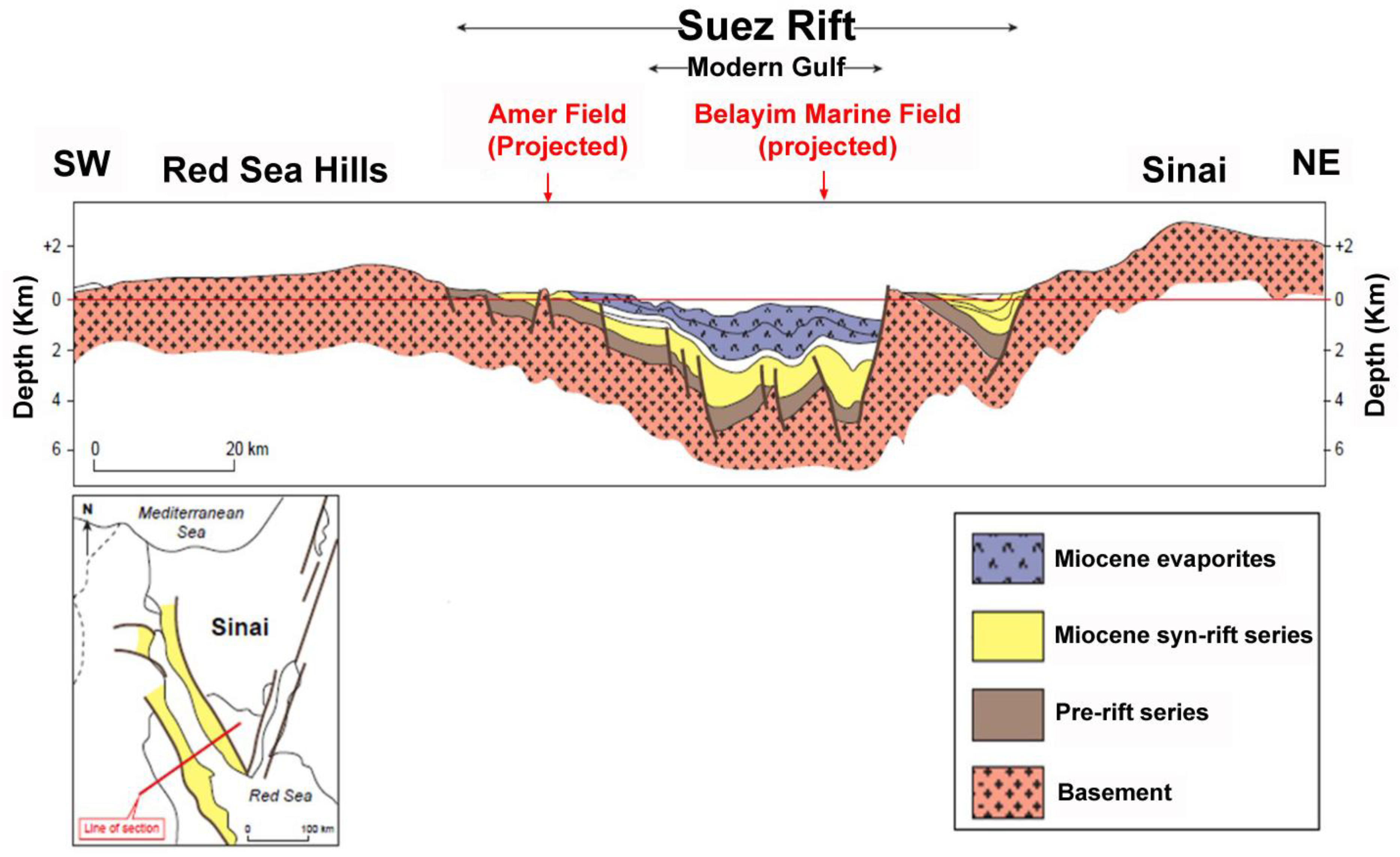
3. Materials and Methods
3.1. Sample Collection
3.2. Foraminiferal Analysis
3.2.1. Sample Preparation for Biostratigraphy
3.2.2. Foraminiferal Identification and Imaging
3.3. Paleoenvironmental Reconstruction Using Foraminiferal Proxies
3.3.1. Paleoclimatic Analysis
- Warm-water indicators, representing tropical and subtropical taxa, receive a score of +1.
- Cold-water indicators, including subpolar and gyre margin taxa, are assigned a score of −1.
- (A) Tropical assemblages
- (B) Assemblages of subtropical origins
- (C) Subpolar assemblages
- (D) Gyre margin assemblages
3.3.2. Paleobathymetric Analysis
- Planktonic/Benthic (P/B) Ratios: P/P + B × 100 with a high percentage (>80%) as representing a distal, deep-marine environment.
- Fisher Alpha (alpha): alpha = N (1 − x)/x (N is the total number of specimens, and x is the Simpson structure concentration) measures of water depth-associated gradients in diversity. This index correlates with water depth through non-linear diversity gradients: values are lowest in shallow stressed settings (e.g., supralittoral: α < 2), higher on continental shelves (α = 5–15), reduced in bathyal zones, and peak in abyssal plains (α = 5–20) [77,78,79,80].
- Ref. [81] Depth Equation:in which %P = P/P + B 100, P = planktonic, B = benthic counts. It rounded out several proxies in finding bathyal depths (>600 m) of the eastern Gulf where light restriction inhibited carbonate factories despite suitable SSTs.Depth (m) = e(3.58718 + 0.03534 × %P)
3.4. Sequence Stratigraphy
| Species | Temperature Tolerance | Provinces | References |
|---|---|---|---|
| Trilobatus trilobus | Warm | Tropical | 4, 10, 11, 12 |
| Trilobatus bisphericus | Warm | Tropical to Subtropical | 1, 3, 4, 5 |
| Globigerinella obesa | Warm | Tropical to Subtropical | 10 |
| Globigerinoides subquadratus | Warm | Tropical to Subtropical | 4, 10, 14 |
| Globoturborotalita occlusa | Warm | Tropical to Subtropical | 10, 15, 16 |
| Globoturborotalita pseudopraebulloides | Warm | Tropical to Subtropical | 10, 17 |
| Praeorbulina curva | Warm | Tropical to Subtropical | 1, 2, 4 |
| Tenuitella clemenciae | Warm | Tropical to Subtropical | 2 |
| Trilobatus sicanus | Warm | Tropical to Subtropical | 1, 2, 4, 13 |
| Globigerinella praesiphonifera | Warm | Tropical to Subtropical | 4, 10 |
| Praeorbulina glomerosa | Warm | Tropical to Subtropical | 1, 2, 4 |
| Praeorbulina circularis | Warm | Tropical to Subtropical | 1, 2 |
| Globigerinoides italicus | Warm | Tropical to Subtropical | 10 |
| Dentoglobigerina venezuelana | Warm | Tropical to Subtropical | 8, 13, 19, 20, 21 |
| Globigerina officinalis | Warm | Tropical to Subtropical | 10 |
| Orbulina suturalis | Warm | Tropical to Temperate | 1, 2 |
| Globigerinella siphonifera | Warm | Tropical to Temperate | 1, 2, 22 |
| Globigerina falconensis | Cold | Tropical to Temperate | 1, 2 |
| Trilobatus altospiralis | Cold | Temperate to Subpolar | 9, 10 |
| Trilobatus immaturus | Warm | Cosmopolitan | 10, 23, 24 |
| Globigerinoides obliquus | Warm | Cosmopolitan | 10, 24, 25 |
| Trilobatus quadrilobatus | Warm | Cosmopolitan | 10, 24, 25 |
| Globoturborotalita woodi | Warm | Cosmopolitan | 4, 6, 9, 10, 26 |
| Turborotalita quinqueloba | Warm | Cosmopolitan | 17, 43, 44 |
| Globigerinita glutinata | Warm | Cosmopolitan | 17 |
| Globoquadrina dehiscens | Warm | Cosmopolitan | 3, 24 |
| Paragloborotalia siakensis | Warm | Cosmopolitan | 2, 9, 18 |
| Globigerinita uvula | Temperate | Cosmopolitan | 9 |
| Globigerina bulloides | Cold | Cosmopolitan | 1, 2, 10, 27, 28, 29, 30 |
| Orbulina universa | Cold | Cosmopolitan | 1, 2, 22 |
| Catapsydrax unicavus | Cold | Cosmopolitan | 7, 8, 17, 31, 32, 33, 34 |
| Globorotaloides suteri | Cold | Cosmopolitan | 7, 8, 35, 36 |
3.5. Petrophysical Parameters
3.5.1. Well Log Analysis
3.5.2. Core Analysis (Special Core Analysis Laboratory—SCAL)
3.6. Electrical Properties Determination
3.6.1. Cementation Exponent and Tortuosity Factor
3.6.2. Saturation Exponent
- Cleaned State:
- 2.
- Restored State:
4. Results
4.1. Biostratigraphy and Age Determination
- Orbulina suturalis—The species is a significant evolutionary step in developing the Orbulina lineage at the base of the M6 Zone at c. 15.12 Ma (Table 3).
- Orbulina universa—We found the first occurrence of this species at the same biostratigraphic level, providing additional chronostratigraphic control (Table 3).
- Praeorbulina circularis—The disappearance of this species around 14.89 Ma stands out as a significant evolutionary transition in the time range considered here (Table 3).
- Praeorbulina glomerosa s. str.—The final appearance of this subspecies is dated at around 14.78 Ma, which gives the constraint on the upper part of the succession under study (Table 3).
4.2. Paleoclimatic Reconstruction
4.3. Paleobathymetric Reconstruction
4.4. Sequence Stratigraphic Framework
4.5. Petrophysical Analysis
4.6. Petrographic Analysis
4.7. Core Analysis (SCAL) Results
- Sample 5 (2722.31 m): Low entry pressure (6.75 psi), pore throat radii ranging from 1.28–0.049 μm (Figure 16A), and unimodal distribution, confirming excellent pore connectivity and flow capacity.
- Sample 12 (2726.03 m): Higher entry pressure (13.4 psi), finer pore throats (0.63–0.032 μm; Figure 16B), and multimodal distribution, revealing pore-filling clay (kaolinite) and dolomite cement as permeability inhibitors.
- Quartz-rich zones exhibit low cementation exponents (m = 1.9), unimodal MICP curves, and preferential hydrocarbon wettability, favoring efficient hydrocarbon flow and recovery.
- Dolomite-cemented intervals show elevated saturation exponents (n = 2.3), high entry pressures, and complex pore throat distributions, acting as flow baffles that compartmentalize the reservoir.
- Mixed wettability characteristics create heterogeneous flow patterns that influence sweep efficiency and require tailored completion strategies.
5. Discussion
5.1. Multifactorial Controls on Carbonate Depletion and Clastic Dominance
5.1.1. Influence of Paleoclimate
5.1.2. Influence of Paleobathymetry
5.1.3. Comparative Geological Factors: Eastern vs. Western Gulf of Suez
- The dichotomy is a result of the different geologic circumstances of the rift basin that created disparate depositional settings in the form of four interplaying main factors (Table 1):
- Depositional Environment: The eastern basin was a high-energy, turbid, deep-marine bathyal environment (>600 m) that suppressed carbonates, while the western shelf was in the neritic zone (<100 m), where clear, shallow water promoted extensive reefal growth.
- Sediment Supply: Proximity to the Nubian Shield brought an abundance of quartzose clastics into the eastern trough via fault-scarp drainage networks that diluted the potential of carbonate. The paleohigh-bound western platform received minimal terrigenous supply and predominantly featured in situ carbonate (Figure 17A).
- Sea-Level Changes: High-amplitude sea-level fluctuations in the east caused repetitive alternation between clastic (lowstand) and mixed carbonate–clastic (highstand) sedimentation, which disrupted the continuity of carbonate factories. Sea levels in the west were stable, with ongoing reefal growth (Figure 17B).
5.2. Sequence Stratigraphic and Petrophysical Interpretation
5.3. Correlation of Local Sequences with Regional and Global Events
6. Summary and Conclusions
- Account for compaction effects and pore-throat heterogeneity (MICP data) in static/dynamic models.
- Prioritize clay stabilization and wettability-modifying surfactants in EOR designs.
- Map “sweet spots” using 3D seismic and diagenetic studies to target quartz-rich HST2 zones.
Author Contributions
Funding
Data Availability Statement
Conflicts of Interest
References
- Bosworth, W. A model for the three-dimensional evolution of continental rift basins, north-east Africa. Geol. Rundschau 1994, 83, 671–688. [Google Scholar] [CrossRef]
- Moustafa, A.M. Block Faulting of the Gulf of Suez. In Proceedings of the 5th Exploration Seminar; Unpublished Report; Egyptian General Petroleum Company: Cairo, Egypt, 1976; pp. 1–19. [Google Scholar]
- Ayyad, H.M.; Fathy, M.; Hewaidy, A.G.A.; Abdallah, A. Sequence stratigraphy of the Burdigalian Rudeis Formation in Ras El-Ush oil field, Gulf of Suez: Application of gamma-ray analysis and biostratigraphy. Mar. Pet. Geol. 2020, 122, 104694. [Google Scholar] [CrossRef]
- Khattab, M.A.; Radwan, A.E.; El-Anbaawy, M.I.; Mansour, M.H.; El-Tehiwy, A.A. Three-dimensional structural modelling of structurally complex hydrocarbon reservoir in October Oil Field, Gulf of Suez, Egypt. Geol. J. 2023, 58, 4146–4164. [Google Scholar] [CrossRef]
- Othman, A.A.A.; Fathy, M.; Hashem, M.E. Three-dimensional static reservoir modelling of Kareem sandstone reservoir, Tawilla Oil Field, at the southern region of Gulf of Suez, Egypt. Geol. J. 2024, 59, 3258–3277. [Google Scholar] [CrossRef]
- Lee, E.Y.; Fathy, D.; Xiang, X.; Spahić, D.; Ahmed, M.S.; Fathi, E.; Sami, M. Middle Miocene syn-rift sequence on the central Gulf of Suez, Egypt: Depositional environment, diagenesis, and their roles in reservoir quality. Mar. Pet. Geol. 2025, 174, 107305. [Google Scholar] [CrossRef]
- Moawad, S.K.; Baghdady, A.R.; Moustafa, A.R.; Helmy, H.M.; El-Hadidy, S.M. Structural control on basin architecture and hydrocarbon play types of the Miocene carbonate reservoirs, southern Gulf of Suez rift, Egypt. Mar. Pet. Geol. 2025, 177, 107365. [Google Scholar] [CrossRef]
- Nabawy, B.S.; Mansour, A.S.; Rashed, M.A.; Afify, W.S.M. Implementation of sedimentary facies and diagenesis on the reservoir quality of the Aquitanian-Burdigalian Rudeis Formation in the Gulf of Suez, Egypt: A comparative surface and subsurface study. Geol. J. 2020, 55, 4543–4563. [Google Scholar] [CrossRef]
- Sallam, E.S.; Ruban, D.A. Facies analysis and depositional environments of the Miocene syn-rift carbonate–siliciclastic rock packages in the northwest Gulf of Suez, Egypt. Carbonates Evaporites 2020, 35, 10. [Google Scholar] [CrossRef]
- Abouelhassan, M.M.; Abu-Hashish, M.F.; Ashry, H.M. Impact of diagenetic processes on the petrophysical properties and quality of the Miocene “Reefal limestone” reservoir in Al-Hamd field, Gulf of Suez, Egypt. Carbonates Evaporites 2021, 36, 21. [Google Scholar] [CrossRef]
- Said, S.M.; Sakran, S. Geometry and kinematics of right-lateral transpressional faults and growth folds, the western side of the Gulf of Suez, Egypt. Geol. J. 2022, 57, 276–291. [Google Scholar] [CrossRef]
- Gawthorpe, R.L.; Jackson, C.A.-L.; Young, M.J.; Sharp, I.R.; Moustafa, A.R.; Leppard, C.W. Normal fault growth, displacement localisation and the evolution of normal fault populations: The Hammam Faraun fault block, Suez rift, Egypt. J. Struct. Geol. 2003, 25, 883–895. [Google Scholar] [CrossRef]
- Sobhy, H.; Moustafa, A.R. Impact of structural geometry of tilted fault blocks on hydrocarbon entrapment and deposition of syn-rift clastic reservoirs: Belayim Marine field (Gulf of Suez rift). Mar. Pet. Geol. 2024, 160, 106631. [Google Scholar] [CrossRef]
- El Zefzaf, T.; El Fattah, M.A.; Proett, M.A.; Engelman, B.; Bassiouny, A. Formation Testing and Sampling Using an Oval Pad in Al Hamd Field, Egypt. In Proceedings of the SPE Annual Technical Conference and Exhibition, San Antonio, TX, USA, 24–27 September 2006; Volume 3, pp. 1816–1826. [Google Scholar]
- Ali, A.; Abdelhady, A.A.; Mohamed, R.S.A.; Fathy, D.; Hashem, M.; Ahmed, M.S.; Aboueldahab, S.M.; Khalil, M.M.; Farag, M.H. Depositional and diagenetic drivers of heterogeneous reservoir quality in the Neogene strata of the Red Sea (Egypt). Carbonates Evaporites 2025, 40, 88. [Google Scholar] [CrossRef]
- Bosworth, W. Geological Evolution of the Red Sea: Historical Background, Review, and Synthesis. In The Red Sea; Rasul, N.M.A., Stewart, I.C.F., Eds.; Springer: Berlin/Heidelberg, Germany, 2015; pp. 45–78. ISBN 978-3-662-45201-1. [Google Scholar]
- Ayyad, H.M.; Hewaidy, A.G.A.; Omar, M.; Fathy, M. Sequence stratigraphy and reservoir quality of the Gulf of Suez syn-rift deposits of the Nukhul formation: Implications of rift initiation and the impact of eustacy and tectonic on deposition. Mar. Pet. Geol. 2023, 156, 106459. [Google Scholar] [CrossRef]
- Hewaidy, A.G.A.; Farouk, S.; Ayyad, H.M. Nukhul formation in wadi baba, southwest sinai peninsula, Egypt. GeoArabia 2012, 17, 103–120. [Google Scholar] [CrossRef]
- Hewaidy, A.G.A.; Farouk, S.; Ayyad, H.M. Foraminifera and sequence stratigraphy of Burdigalian—Serravallian successions on the eastern side of the Gulf of Suez, southwestern Sinai, Egypt. Neues Jahrb. Geol. Paläontol.-Abh. 2013, 270, 151–170. [Google Scholar] [CrossRef]
- Hewaidy, A.G.A.; Farouk, S.; Ayyad, H.M. Integrated biostratigraphy of the upper Oligocene-middle Miocene successions in west central Sinai, Egypt. J. Afr. Earth Sci. 2014, 100, 379–400. [Google Scholar] [CrossRef]
- Karaca, E.; Yılmaz, İ.Ö.; Çifci, G.; Tortopoğlu, B.; Akın, S. Integrated fracture analysis for improved oil recovery in the reefal limestones of Soğucak formation, Northwest Thrace Basin, Türkiye. Mar. Pet. Geol. 2025, 171, 107198. [Google Scholar] [CrossRef]
- Scott, R.W.; Govean, F.M. Early depositional history of a rift basin: Miocene in Western Sinai. Palaeogeogr. Palaeoclimatol. Palaeoecol. 1985, 52, 143–158. [Google Scholar] [CrossRef]
- Mansour, A.S.; Abd-Ellatif, M.T. Dolomitization of the Miocene carbonates in Gebel Abu Shaar El Qiblie and Salum area, Egypt: A petrographical and geochemical comparative study. Carbonates Evaporites 2013, 28, 347–363. [Google Scholar] [CrossRef]
- El-Fakharany, M.; Afife, M.; Fares, M. Reservoir quality of Nullipore formation, Ras Fanar oil field concession, Gulf of Suez, Egypt. Int. J. Sci. Eng. Appl. Sci. 2016, 2, 368–383. [Google Scholar]
- Noyahr, C.V.; Weissenberger, J.A.W.; Harris, N.B.; Banks, J. A facies- and sequence stratigraphy-based reservoir model for a carbonate reef complex: South Swan Hills oil pool, Alberta. Mar. Pet. Geol. 2023, 152, 106226. [Google Scholar] [CrossRef]
- Youssef, E.-S.A.A. Dolomitization and dedolomitization of Miocene carbonates at Gabal El-Safra, Sherm el Sheikh area, sinai, Egypt. Carbonates Evaporites 1997, 12, 185–191. [Google Scholar] [CrossRef]
- Chowdhary, L.R.; Taha, S. History of exploration and geology of Ras Budran, Ras Fanar and Zeit Bay oil fields. In Proceedings of the Egyptian General Petroleum Corporation, 8th Exploration Conference, Cairo, Egypt, 17–23 November 1986; p. 42. [Google Scholar]
- Kassab, M.; El Gebaly, A.; Abass, A.; El Kady, E. Integrated petrophysical and mineral composition of Miocene reservoirs (Kareem and Belayim Formations), Belayim onshore oil field, Gulf of Suez, Egypt: A case study. Arab. J. Geosci. 2021, 14, 1–18. [Google Scholar] [CrossRef]
- Thiébaud, C.E.; Robson, D.A. the Geology of the Area Between Wadi Wardan and Wadi Gharandal, East Clysmic Rift, Sinai, Egypt. J. Pet. Geol. 1979, 1, 63–75. [Google Scholar] [CrossRef]
- Aziz, E.A.A.E.; Gomaa, M.M. Petrophysical and seismic evaluation of pre rift sediments of the southern Gulf of Suez basin, Egypt. Carbonates Evaporites 2024, 39, 96. [Google Scholar] [CrossRef]
- Corlett, H.; Hodgetts, D.; Hirani, J.; Rotevatn, A.; Taylor, R.; Hollis, C. A geocellular modelling workflow for partially dolomitized remobilized carbonates: An example from the Hammam Faraun Fault block, Gulf of Suez, Egypt. Mar. Pet. Geol. 2021, 126, 104831. [Google Scholar] [CrossRef]
- Jamil, M.; Siddiqui, N.A.; Rahman, A.H.B.A.; Ibrahim, N.A.; Bin Ismail, M.S.; Ahmed, N.; Usman, M.; Gul, Z.; Imran, Q.S. Facies heterogeneity and lobe facies multiscale analysis of deep-marine sand-shale complexity in the West Crocker Formation of Sabah Basin, NW Borneo. Appl. Sci. 2021, 11, 5513. [Google Scholar] [CrossRef]
- Patton, T.L.; Moustafa, A.R.; Nelson, R.A.; Abdine, S.A. Tectonic Evolution and Structural Setting of the Suez Rift. In Interior Rift Basins; American Association of Petroleum Geologists: Tulsa, OK, USA, 1994; pp. 9–55. Available online: https://pubs.geoscienceworld.org/books/book/1314/chapter/107170273 (accessed on 1 January 1994).
- Ali Ali, E.K.; Emad El Din Abd Elrazik, E.; Shebl Azam, S.; Ahmed Hassan, S. Integrated petrophysical and lithofacies studies of lower-middle Miocene reservoirs in Belayim marine oil field, Gulf of Suez, Egypt. J. Afr. Earth Sci. 2016, 117, 331–344. [Google Scholar] [CrossRef]
- Younes, A.I.; McClay, K.R. Development of accommodation zones in the Gulf of Suez-Red Sea rift, Egypt. Am. Assoc. Pet. Geol. Bull. 2002, 86, 1003–1026. [Google Scholar] [CrossRef]
- Moustafa, A.R.; Abdeen, M.M. Structural setting of the Hammam Faraun block, eastern side of the Suez rift. J. Univ. Kuwait 1992, 19, 291–309. [Google Scholar]
- Henaish, A.; El Shinawi, A.; Awad, M. Internal architecture and structural evolution of a horst relay zone from the northern Gulf of Suez rift, Egypt: Implications for syn-rift sedimentation. Mar. Pet. Geol. 2023, 150, 106170. [Google Scholar] [CrossRef]
- Ayyad, H.M.; Hewaidy, A.G.A.; Farouk, S.; Samir, A.; Bazeen, Y.S. Sequence stratigraphy of the upper Oligocene–middle Miocene succession in west–central Sinai, Egypt. Geol. J. 2023, 58, 264–282. [Google Scholar] [CrossRef]
- Bosworth, W.; McCaly, K. Structural and stratigraphic evolution of the Gulf of Suez rift, Egypt: A synthesis. In Peri-Tethyan Rift/Wrench Basins and Passive Margins; Ziegler, P.A., Cavazza, W., Robertson, A.H.F., Crasquin- Soeau, S., Eds.; Mémoire Musee Histoire Naturelle, PeriTethys Memoir 6; French National Museum Natural History: Paris, France, 2001; Volume 186, pp. 567–606. [Google Scholar]
- Kehew, A.E.; Milewski, A.; Soliman, F. Reconstructing an extreme flood from boulder transport and rainfall–runoff modelling: Wadi Isla, South Sinai, Egypt. Glob. Planet. Chang. 2010, 70, 64–75. [Google Scholar] [CrossRef]
- Bosworth, W.; Khalil, S.; Clare, A.; Comisky, J.; Abdelal, H.; Reed, T.; Kokkoros, G. Integration of outcrop and subsurface data during the development of a naturally fractured Eocene carbonate reservoir at the East Ras Budran concession, Gulf of Suez, Egypt. Geol. Soc. Spec. Publ. 2014, 374, 333–359. [Google Scholar] [CrossRef]
- Deaf, A.S.; El Soughier, M.I.; Gentzis, T.; Makled, W.A. Hydrocarbon source rock potential of the Lower Eocene carbonates from the Abu Darag sub-basin, Gulf of Suez, Egypt: Integrated organic geochemical and petrographic analyses. Mar. Pet. Geol. 2021, 132, 105235. [Google Scholar] [CrossRef]
- Zwaan, F.; Schreurs, G.; Adam, J. Effects of sedimentation on rift segment evolution and rift interaction in orthogonal and oblique extensional settings: Insights from analogue models analysed with 4D X-ray computed tomography and digital volume correlation techniques. Glob. Planet. Chang. 2018, 171, 110–133. [Google Scholar] [CrossRef]
- Bosworth, W.; Huchon, P.; McClay, K. The Red Sea and Gulf of Aden Basins. J. Afr. Earth Sci. 2005, 43, 334–378. [Google Scholar] [CrossRef]
- Richardson, M.; Arthur, M.A. The Gulf of Suez-northern Red Sea neogene rift: A quantitive basin analysis. Mar. Pet. Geol. 1988, 5, 247–270. [Google Scholar] [CrossRef]
- Orszag-Sperber, F.; Harwood, G.; Kendall, A.; Purser, B.H. A Review of the Evaporites of the Red Sea-Gulf of Suez Rift BT—Sedimentation and Tectonics in Rift Basins Red Sea:-Gulf of Aden; Purser, B.H., Bosence, D.W.J., Eds.; Springer: Dordrecht, The Netherlands, 1998; pp. 409–426. [Google Scholar] [CrossRef]
- Hewaidy, A.G.A.; Abd El-Moghny, M.W.; Ayyad, H.M.; Gameel, O. Biostratigraphy, microfacies analysis and sequence stratigraphy of the Miocene succesions in Cairo-Suez District, Egypt. AI Azhar Bull. Sci. 2018, 29, 39–59. [Google Scholar]
- Ayyad, H.; Hewaidy, A.G.; Hewaidy, A. Chattian-Aquitanian calcareous nannofossil biostratigraphy of the Nukhul Formation in Wadi Baba Section, West Central Sinai, Egypt. Stratigraphy 2016, 13, 67–81. [Google Scholar] [CrossRef]
- Evans, A.L. Miocene sandstone provenance relations in the Gulf of Suez: Insights into synrift unroofing and uplift history. Am. Assoc. Pet. Geol. Bull. 1990, 74, 1386–1400. [Google Scholar] [CrossRef]
- Snyder, S.W.; Huber, B.T. Preparation Techniques for Use of Foraminifera in the Classroom. Paleontol. Soc. Pap. 1996, 2, 231–236. [Google Scholar] [CrossRef]
- Hewaidy, A.A.; Ayyad, H.M.; Labaidy, N. Biostratigraphy of the Miocene successions in the Sadat Area, west Gulf of Suez-Egypt. Egypt. J. Geol. 2020, 64, 455–470. [Google Scholar] [CrossRef]
- Hewaidy, A.G.A.; Ayyad, H.M.; Abdallah, A. Subsurface lower–middle Miocene biostratigraphy of Ras El Ush oil field, G. Zeit Area, Gulf of Suez, Egypt. AI Azhar Bull. Sci. 2018, 29, 1–18. [Google Scholar]
- Berggren, W.A.; Kent, D.V.; Swisher, C.C.; Aubry, M.-P. A Revised Cenozoic Geochronology and Chronostratigraphy. In Geochronology, Time Scales and Global Stratigraphic Correlation; SEPM Society for Sedimentary Geology: Tulsa, OK, USA, 1995; pp. 129–212. Available online: https://pubs.geoscienceworld.org/books/book/1041/chapter/10528799 (accessed on 1 January 1995).
- Lourens, L.; Hilgen, F.; Shackleton, N.J.; Laskar, J.; Wilson, D. The Neogene Period BT—A Geologic Time Scale; Gradstein, F., Ogg, J., Smith, A., Eds.; Cambridge University Press: Cambridge, UK, 2004. [Google Scholar]
- Wade, B.S.; Pearson, P.N.; Berggren, W.A.; Pälike, H. Review and revision of Cenozoic tropical planktonic foraminiferal biostratigraphy and calibration to the geomagnetic polarity and astronomical time scale. Earth-Sci. Rev. 2011, 104, 111–142. [Google Scholar] [CrossRef]
- Coxall, H.K.; Spezzaferri, S.; Sciences, O.; Building, M.; Place, P.; Sciences, E. Taxonomy, Biostratigraphy, and Phylogeny of Oligocene Catapsydrax, Globorotaloides, and Protentelloides. In Atlas of Oligocene Planktonic Foraminifera; Cushman Foundation for Foraminiferal Research: Lawrence, KS, USA, 2018; pp. 79–124. [Google Scholar]
- Hardenbol, J.; Thierry, J.; Farley, M.B.; Jacquin, T.D.; Graciansky, P.C.; Vail, P.R. Mesozoic and Cenozoic sequence chronostratigraphic framework of European basins. In Mesozoic and Cenozoic Sequence Stratigraphy of European Basins; SEPM Society for Sedimentary Geology: Tulsa, OK, USA, 1998; Volume 60. [Google Scholar]
- King, D.J.; Wade, B.S.; Liska, R.D.; Miller, C.G. A review of the importance of the Caribbean region in Oligo-Miocene low latitude planktonic foraminiferal biostratigraphy and the implications for modern biogeochronological schemes. Earth-Sci. Rev. 2020, 202, 102968. [Google Scholar] [CrossRef]
- Souaya, F.J. Miocene Foraminifera of the Gulf of Suez Region, U.A.R. Part 4: Paleoecology and Age. Micropaleontology 1966, 12, 493. [Google Scholar] [CrossRef]
- Berggren, W.A.; Hilgen, F.J.; Langereis, C.G.; Kent, D.V.; Obradovich, J.D.; Raffi, I.; Raymo, M.E.; Shackleton, N.J. Late Neogene chronology: New perspectives in high-resolution stratigraphy. Geol. Soc. Am. Bull. 1995, 107, 1272–1287. [Google Scholar] [CrossRef]
- Cicha, I.; Rögl, F.; Rupp, C.; Ctyroka, J. Oligocene–Miocene Foraminifera of the Central Paratethys. Abh. Senckenberg. Naturforschenden Ges. 1998, 549, 1–325. [Google Scholar]
- Holbourn, A.; Henderson, A.S.; MacLeod, N. Atlas of Benthic Foraminifera; Natural History Museum: London, UK, 2013; 642p. [Google Scholar]
- Wade, B.S.; Pearson, P.N.; Olsson, R.K.; Fraass, A.J.; Leckie, R.M.; Hemleben, C. Taxonomy, Biostratigraphy, and Phylogeny of Oligocene and Lower Miocene Dentoglobigerina and Globoquadrina. In Atlas of Oligocene Planktonic Foraminifera; Wade, B.S., Olsson, R.K., Pearson, P.N., Huber, B.T., Berggren, W.A., Eds.; Cushman Foundation for Foraminiferal Research: Glen Allen, VA, USA, 2018; Volume 46. [Google Scholar]
- Bé, A.W.H. An ecological, zoogeographic and taxonomic review of recent planktonic foraminifera. In Oceanic Micropaleontology; Academic Press: London, UK, 1977; pp. 1–100. [Google Scholar]
- Hewaidy, A.G.A.; Farouk, S.; Ayyad, H.M. Paleoclimatic Analysis of the Late Oligocene/Middle Miocene Planktonic Fauna of West Central Siani, Egypt. Egypt. J. Paleontol. 2013, 13, 29–48. [Google Scholar]
- Langodan, S.; Cavaleri, L.; Portilla, J.; Abualnaja, Y.; Hoteit, I. Can we extrapolate climate in an inner basin? The case of the Red Sea. Glob. Planet. Chang. 2020, 188, 103151. [Google Scholar] [CrossRef]
- Cita, M.B.; Vergnaud-Grazzini, C.; Robert, C.; Chamley, H.; Ciaranfi, N.; d’Onofrio, S. Paleoclimatic record of a long deep sea core from the eastern Mediterranean. Quat. Res. 1977, 8, 205–235. [Google Scholar] [CrossRef]
- Spezzaferri, S. Planktonic foraminiferal paleoclimatic implications across the Oligocene-Miocene transition in the oceanic record (Atlantic, Indian and South Pacific). Palaeogeogr. Palaeoclimatol. Palaeoecol. 1995, 114, 43–74. [Google Scholar] [CrossRef]
- Rögl, F.; Spezzaferri, S. Foraminiferal paleoecology and biostratigraphy of the Mühlbach section (Gaindorf Formation, Lower Badenian), Lower Austria. Ann. Naturhistorischen Museums Wien. Ser. A für Mineral. Petrogr. Geol. Paläontologie Anthropol. Prähistorie 2002, 104, 23–75. [Google Scholar]
- Antonarakou, A.; Drinia, H.; Tsaparas, N.; Dermitzakis, M.D. Micropaleontological parameters as proxies of late Miocene surface water properties and paleoclimate in Gavdos Island, eastern Mediterranean. Geodiversitas 2007, 29, 379–399. [Google Scholar]
- Ayyad, H.M.; Bazeen, Y.S.; Samir, A.; Ghanem, S.G.; Ali, A.H.; Gaafar, A.T.; Abdel-Gawad, A. Foraminiferal Proxies Reveal Miocene Climatic Shifts in the Gulf of Suez: Insights from the Rudeis and Kareem Formations on Lithostratigraphic Ambiguities and Central Paratethys Climatic Linkages During Burdigalian-Langhian Intervals. Geol. J. 2025. [Google Scholar] [CrossRef]
- Imbrie, J.; Kipp, N. A New Micropaleontological Method for Quantitative Paleoclimatology: Application to a Late Pleistocene Caribbean Core. In The Late Cenozoic Glacial Ages; Yale University Press: New Haven, CT, USA, 1971; pp. 71–181. Available online: https://cir.nii.ac.jp/crid/1570572700955781248 (accessed on 12 May 2025).
- Guiot, J.; de Vernal, A. Chapter Thirteen Transfer Functions: Methods for Quantitative Paleoceanography Based on Microfossils. Dev. Mar. Geol. 2007, 1, 523–563. [Google Scholar] [CrossRef]
- Saraswati, P.K.; Srinivasan, M.S. Micropaleontology. Micropaleontology: Principles and Applications; Springer International Publishing: Cham, Switzerland, 2016; pp. 1–224. Available online: http://link.springer.com/10.1007/978-3-319-14574-7 (accessed on 29 December 2015).
- Nikolaev, S.D.; Oskina, N.S.; Blyum, N.S.; Bubenshchikova, N.V. Neogene–Quaternary variations of the ‘Pole–Equator’ temperature gradient of the surface oceanic waters in the North Atlantic and North Pacific. Glob. Planet. Chang. 1998, 18, 85–111. [Google Scholar] [CrossRef]
- Bonnefille, R. Cenozoic vegetation, climate changes and hominid evolution in tropical Africa. Glob. Planet. Chang. 2010, 72, 390–411. [Google Scholar] [CrossRef]
- Murray, J.W. Ecology and Applications of Benthic Foraminifera; Cambridge University Press: Cambridge, UK, 2006; pp. 1–426. [Google Scholar]
- Douglas, R.G.; Woodruff, F. Deep sea benthic foraminifera. Sea 1981, 7, 1233–1327. [Google Scholar]
- Pippèrr, M. Characterisation of Ottnangian (middle Burdigalian) palaeoenvironments in the North Alpine Foreland Basin using benthic foraminifera-A review of the Upper Marine Molasse of southern Germany. Mar. Micropaleontol. 2011, 79, 80–99. [Google Scholar] [CrossRef]
- Ayyad, H.M.; El-Sharnoby, A.A.; El-Morsy, A.M.; Ahmed, M.A.; El-Deeb, A.A. Quantitative reconstruction of paleoenvironmental conditions in the Gulf of Suez during the Burdigalian-Langhian (early to middle Miocene) using benthic foraminifera. Palaeogeogr. Palaeoclimatol. Palaeoecol. 2018, 503, 51–68. [Google Scholar] [CrossRef]
- Van Der Zwaan, G.J.; Jorissen, F.J.; de Stigter, H.C. The depth dependency of planktonic/benthic foraminiferal ratios: Constraints and applications. Mar. Geol. 1990, 95, 1–16. [Google Scholar] [CrossRef]
- Selley, R.C. Porosity gradients in North Sea oil-bearing sandstones. J. Geol. Soc. London 1978, 135, 119–132. [Google Scholar] [CrossRef]
- Selley, R.C. Elements of Petroleum Geology; Gulf Professional Publishing: London, UK, 1998; pp. 37–145. [Google Scholar]
- Aze, T.; Ezard, T.H.G.; Purvis, A.; Coxall, H.K.; Stewart, D.R.M.; Wade, B.S.; Pearson, P.N. A phylogeny of Cenozoic macroperforate planktonic foraminifera from fossil data. Biol. Rev. 2011, 86, 900–927. [Google Scholar] [CrossRef]
- Kennett, J.P.; Srinivasan, M.S. Neogene Planktonic Foraminifera: A Phylogenetic Atlas; Distributed by Worldwide by Van Nostrand Reinhold; Hutchinson Ross: New York, NY, USA, 1983; p. 265. Available online: https://searchworks.stanford.edu/view/1047922 (accessed on 18 October 1983).
- Keller, G. Depth stratification of planktonic foraminifers in the Miocene ocean. In The Miocene Ocean: Paleoceanography and Biogeography; Kennett, J.P., Ed.; Geological Society of America: Boulder, CO, USA, 1985. [Google Scholar] [CrossRef]
- Pearson, N.; Shackelton, J.; Hall, A.M. Stable isotopic evidence for the sympatric divergence of Globigerinoides trilobus and Orbulina universa (planktonic foraminifera). J. Geol. Soc. Lond. 1997, 154, 295–302. [Google Scholar] [CrossRef]
- Pearson, P.N.; Shackleton, N.J. 20. Neogene Multispecies Planktonic Foraminifer Stable Isotope Record, site 871, limalok guyot1. Proc. Ocean. Drill. Program. Sci. Results 1995, 144, 401–410. [Google Scholar]
- Poore, R.Z.; Matthews, R.K. Oxygen isotope ranking of late Eocene and Oligocene planktonic foraminifers: Implications for Oligocene sea-surface temperatures and global ice-volume. Mar. Micropaleontol. 1984, 9, 111–134. [Google Scholar] [CrossRef]
- Spezzaferri, S. Planktonic Foraminiferal Biostratigraphy and Taxonomy of the Oligocene and Lower Miocene in the Oceanic Record: An Overview; Palaeontographia Italica; Pacini Editore: Pisa, Italy, 1994; Available online: https://books.google.com.eg/books?id=sANkuAAACAAJ (accessed on 10 August 2025).
- Spezzaferri, S.; Olsson, R.K.; Hemleben, C. Taxonomy, Biostratigraphy, and Phylogeny of Oligocene to Lower Miocene Globigerinoides and Trilobatus; Wade, B.S., Olsson, R.K., Pearson, P.N., Huber, B.T., Berggren, W.A., Eds.; Atlas of Oligocene Planktonic Foraminifera; Cushman Foundation for Foraminiferal Research: Glen Allen, VA, USA, 2018; Volume 46. [Google Scholar]
- Bé, A.W.H.; Tolderlund, D.S. Distribution and Ecology of Living Planktonic Foraminifera in Surface Waters of the Atlantic and Indian Oceans. The Micropaleontology of Oceans; Cambridge University Press: London, UK, 1971; pp. 105–159. [Google Scholar]
- Hemleben, C.; Spindler, M.; Anderson, O.R. Modern Planktonic Foraminifera, 1st ed.; Springer: New York, NY, USA, 1989; p. XIII-363. Available online: http://link.springer.com/10.1007/978-1-4612-3544-6 (accessed on 6 December 2012).
- Pearson, P.N.; Ditchfield, P.W.; Singano, J.; Harcourt-Brown, K.G.; Nicholas, C.J.; Olsson, R.K.; Shackleton, N.J.; Hall, M.A. Warm tropical sea surface temperatures in the Late Cretaceous and Eocene epochs. Nature 2001, 413, 481–487. [Google Scholar] [CrossRef]
- Todd, R.; Cloud, P.; Low, D.; Schmidt, R. Probable occurrence of Oligocene on Saipan. Am. J. Sci. 1954, 252, 673–682. [Google Scholar] [CrossRef]
- Grunert, P.; Soliman, A.; Ćorić, S.; Roetzel, R.; Harzhauser, M.; Piller, W.E. Facies development along the tide-influenced shelf of the Burdigalian Seaway: An example from the Ottnangian stratotype (Early Miocene, middle Burdigalian). Mar. Micropaleontol. 2012, 84–85, 14–36. [Google Scholar] [CrossRef]
- Stewart, D.R.M.; Pearson, P.N.; Ditchfield, P.W.; Singano, J.M. Miocene tropical Indian Ocean temperatures: Evidence from three exceptionally preserved foraminiferal assemblages from Tanzania. J. Afr. Earth Sci. 2004, 40, 173–189. [Google Scholar] [CrossRef]
- Pearson, P.N.; Wade, B.S. Taxonomy and stable isotope paleoecology of well-preserved planktonic foraminifera from the Upper Oligocene of Trinidad. J. Foraminifer. Res. 2009, 39, 191–217. [Google Scholar] [CrossRef]
- Leckie, M.; Wade, B.; Pearson, P.; Fraass, A.; King, D.; Olsson, R.; Silva, I.; Spezzaferri, S.; Berggren, W. Taxonomy, Biostratigraphy, and Phylogeny of Oligocene and Early Miocene Paragloborotalia and Parasubbotina; Cushman Foundation for Foraminiferal Research: Lawrence, KS, USA, 2018. [Google Scholar]
- Wade, B.; Fucek, V.; Kamikuri, S.-I.; Bartol, M.; Luciani, V.; Pearson, P. Successive extinctions of muricate planktonic foraminifera (Morozovelloides and Acarinina) as a candidate for marking the base Priabonian. Newsl. Stratigr. 2012, 45, 245–262. [Google Scholar] [CrossRef]
- Wade, B.S.; Pearson, P.N. Planktonic foraminiferal turnover, diversity fluctuations and geochemical signals across the Eocene/Oligocene boundary in Tanzania. Mar. Micropaleontol. 2008, 68, 244–255. [Google Scholar] [CrossRef]
- Vergnaud Grazzini, C. Non-equilibrium isotopic compositions of shells of planktonic foraminifera in the Mediterranean sea. Palaeogeogr. Palaeoclimatol. Palaeoecol. 1976, 20, 263–276. [Google Scholar] [CrossRef]
- Gasperi, J.T.; Kennett, J.P. Vertical thermal structure evolution of Miocene surface waters: Western equatorial Pacific DSDP Site 289. Mar. Micropaleontol. 1993, 22, 235–254. [Google Scholar] [CrossRef]
- Chaisson, W.P.; Pearson, P. Planktonic foraminifer biostratigraphy at Site 925: Middle Miocene-Pleistocene. Proc. Ocean Drill. Program Sci. Results 1997, 154, 3–31. [Google Scholar] [CrossRef]
- Hooyberghs, H.J.F.; de Meuter, F.J.C. Biostratigraphy and Interregional Correlation of the Miocene Deposits of Northern Belgium Based on Planktonic Foraminifera: The Oligocene-Miocene Boundary on the Southern Edge of the North Sea Basin. In Mededelingen van de Koninklijke Academie voor Wetenschappen, Letteren en Schone Kunsten van België, Klasse der Wetenschappen; Paleis der Academiën: Brussels, Belgium, 1972; Available online: https://books.google.com.eg/books?id=P6QczwEACAAJ (accessed on 7 October 2020).
- Spero, H.J.; Lea, D.W. Experimental determination of stable isotope variability in Globigerina bulloides: Implications for paleoceanographic reconstructions. Mar. Micropaleontol. 1996, 28, 231–246. [Google Scholar] [CrossRef]
- Niebler, H.-S.; Hubberten, H.-W.; Gersonde, R. Oxygen Isotope Values of Planktic Foraminifera: A Tool for the Reconstruction of Surface Water Stratification BT—Use of Proxies in Paleoceanography: Examples from the South Atlantic; Fischer, G., Wefer, G., Eds.; Springer: Berlin/Heidelberg, Germany, 1999; pp. 165–189. [Google Scholar] [CrossRef]
- Schiebel, R.; Hemleben, C. (Eds.) Classification and Taxonomy of Extant Planktic Foraminifers BT—Planktic Foraminifers in the Modern Ocean; Springer: Berlin/Heidelberg, Germany, 2017; pp. 11–110. [Google Scholar] [CrossRef]
- Brummer, G.-J.; Kucera, M. Taxonomic review of living planktonic foraminifera. J. Micropalaeontol. 2022, 41, 29–74. [Google Scholar] [CrossRef]
- Arthur, M.; Dean, W.; Zachos, J.C.; Kaminski, M.; Reig, S.; Elmstrom, K. Geochemical Expression of Early Diagenesis in Middle Eocene-Lower Oligocene Pelagic Sediments in the Southern Labrador Sea, Site 647, ODP Leg 105. Proc. Ocean. Drill. Program: Sci. Results 1989, 105, 111–135. [Google Scholar]
- van Eijden, A.J.M.; Ganssen, G.M. An Oligocene multi-species foraminiferal oxygen and carbon isotope record from ODP Hole 758A (Indian Ocean): Paleoceanographic and paleo-ecologic implications. Mar. Micropaleontol. 1995, 25, 47–65. [Google Scholar] [CrossRef]
- Wade, B.S.; Berggren, W.A.; Olsson, R.K. The biostratigraphy and paleobiology of Oligocene planktonic foraminifera from the equatorial Pacific Ocean (ODP Site 1218). Mar. Micropaleontol. 2007, 62, 167–179. [Google Scholar] [CrossRef]
- Moore, T.C., Jr.; Wade, B.S.; Westerhold, T.; Erhardt, A.M.; Coxall, H.K.; Baldauf, J.; Wagner, M. Equatorial Pacific productivity changes near the Eocene-Oligocene boundary. Paleoceanography 2014, 29, 825–844. [Google Scholar] [CrossRef]
- Barrera, E.C.; Huber, B.T. Paleogene and early Neogene stable isotope record of foraminifera from ODP Leg 119 samples. PANGAEA. https://doi.org/10.1594/PANGAEA.758193. Barron, J; Larsen, B; et al. (Eds.) Supplement to: Barrera, EC; Huber, BT (1991): Paleogene and Early Neogene Oceanography of the Southern Indian Ocean: Leg 119 Foraminifer Stable Isotope Results. Proc. Ocean. Drill. Program Sci. Results Coll. Stn. (Ocean. Drill. Program) 1991, 119, 693–717. [Google Scholar]
- Sexton, P.F.; Wilson, P.A.; Pearson, P.N. Palaeoecology of late middle Eocene planktic foraminifera and evolutionary implications. Mar. Micropaleontol. 2006, 60, 1–16. [Google Scholar] [CrossRef]
- Boucot, A.J.; Xu, C.; Scotese, C.R.; Morley, R.J. Phanerozoic Paleoclimate: An Atlas of Lithologic Indicators of Climate; SEPM Concepts in Sedimentology and Paleontology: Tulsa, OK, USA, 2013; p. 484. Available online: https://pubs.geoscienceworld.org/books/book/1966 (accessed on 10 August 2025).
- Hammer, Ø.; Harper, D.A.T.; Ryan, P.D. Past: Paleontological statistics software package for education and data analysis. Palaeontol. Electron. 2001, 4, 4. [Google Scholar]
- Ayyad, H.M. Calcareous nannofossil biostratigraphy and paleoclimatology of the Paleocene succession, Tenida area, Western Desert, Egypt. Rev. Micropaleontol. 2018, 61, 37–54. [Google Scholar] [CrossRef]
- Ayyad, H.M.; Hewaidy, A.G.A.; Al-Labaidy, N.A. Sequence stratigraphy of the Miocene siliciclastic–carbonate sediments in Sadat Area, north-west of Gulf of Suez: Implications for Miocene eustasy. Geol. J. 2022, 57, 2255–2270. [Google Scholar] [CrossRef]
- Bazeen, Y.S.; Kassab, W.G.; Moneer, E.S.M.; Abu El-Kheir, G.A.; AbdelGawad, M.K.; Ayyad, H.M. Integrated biostratigraphy and chemostratigraphy of the Maastrichtian–Danian succession at Abu Minqar, Egyptian Western Desert: Implications for sequence stratigraphy and tectonic influence. Cretac. Res. 2024, 154, 105723. [Google Scholar] [CrossRef]
- Mitchum, R.M.; Vail, P.R. Seismic Stratigraphy and Global Changes of Sea Level, Part 7: Seismic Stratigraphic Interpretation Procedure. In Seismic Stratigraphy—Applications to Hydrocarbon Exploration; Payton, C.E., Ed.; American Association of Petroleum Geologists: Tulsa, OK, USA, 1977; Volume 26. [Google Scholar] [CrossRef]
- Catuneanu, O. Principles of Sequence Stratigraphy; Elsevier: Amsterdam, The Netherlands, 2006. [Google Scholar]
- Loutit, T.S.; Hardenbol, J.; Vail, P.R.; Baum, G.R. Condensed Sections: The key to Age Determination and Correlation of Continental Margin Sequences. In Sea-Level Changes: An Integrated Approach; Society of Economic Paleontologists Mineralogists: Tulsa, OK, USA, 1988; pp. 183–213. [Google Scholar]
- Armentrout, J.M. High Resolution Sequence Biostratigraphy: Examples from the Gulf of Mexico Plio-Pleistocene; Geological Society Special Publication: London, UK, 1996; Volume 104, pp. 65–86. [Google Scholar]
- Vail, P.R.; Wornardt, W. An Integrated Approach to Exploration and Development. In Well Log-Seismic Sequence Stratratigraphic Analysis, 41st ed.; Gulf Coast Association of Geological Societies Transactions: Houston, TX, USA, 1991; pp. 630–650. [Google Scholar]
- Hewaidy, A.G.A.; Ayyad, H.M.; Abd El-Moghny, M.W.; Gameel, O. Sequence stratigraphy and biozonation of the Upper Eocene Anqabiya Formation, Gebel Anqabiya, Egypt. Geosci. J. 2019, 23, 357–375. [Google Scholar] [CrossRef]
- Asquith, G.B. Log Evaluation of Shaly Sandstones: A Practical Guide; American Association of Petroleum Geologists: Tulsa, OK, USA, 1990. [Google Scholar] [CrossRef]
- Gawad, E.A.; Fathy, M.; Reda, M.; Ewida, H. Petroleum geology: 3D reservoir modelling in the central Gulf of Suez, Egypt, to estimate the hydrocarbon possibility via petrophysical analysis and seismic data interpretation. Geol. J. 2021, 56, 5329–5342. [Google Scholar] [CrossRef]
- Reda, M.; Fathy, M.; Gawad, E.A. Comprehensive 3D reservoir modelling and basin analysis: An insight into petroleum geology to re-evaluate the hydrocarbon possibilities in the Siwa Basin, North-Western Desert, Egypt. Geol. J. 2022, 57, 1600–1616. [Google Scholar] [CrossRef]
- Ayyad, H.M.; El-Moghny, M.W.A.; Abuseda, H.; Samir, A.; Bazeen, Y.S. Sequence stratigraphy and reservoir characterization of the lower Eocene rocks (Thebes Formation) along the Tethyan Ocean’s southern margin: Biostratigraphy and petrophysical parameter applications. Int. J. Earth Sci. 2023, 112, 1091–1112. [Google Scholar] [CrossRef]
- Asquith, G.; Krygowski, D.; Henderson, S.; Hurley, N. (Eds.) Basic Relationships of Well Log Interpretation; Basic Well Log Analysis; American Association of Petroleum Geologists: Tulsa, OK, USA, 2004; Volume 16. [Google Scholar] [CrossRef]
- Talabani, S.; Boyd, D.; El Wazeer, F.; Al Arfi, S. Validity of Archie Equation in Carbonate Rocks. In Proceedings of the Abu Dhabi International Petroleum Exhibition and Conference, Abu Dhabi, United Arab Emirates, 13–15 October 2000; pp. 643–650. [Google Scholar] [CrossRef]
- Al-Marzouqi, M.I.; Budebes, S.; Sultan, E.; Bush, I.; Griffiths, R.; Gzara, K.B.M.; Ramamoorthy, R.; Husser, A.; Jeha, Z.; Roth, J.; et al. Resolving carbonate complexity. Oilf. Rev. 2010, 22, 40–55. [Google Scholar]
- Van Wagoner, J.C.; Mitchum, R.M.; Campion, K.M.; Rahmanian, V.D. Siliciclastic Sequence Stratigraphy in Well Logs, Cores, and Outcrops: Concepts for High-Resolution Correlation of Time and Facies; American Association of Petroleum Geologists Museum Methods in Exploration Series 7; American Association of Petroleum Geologists: Tulsa, OK, USA, 1990. [Google Scholar]
- Catuneanu, O. Principles of Sequence Stratigraphy, 2nd ed.; Elsevier: Amsterdam, The Netherlands, 2022; ISBN 9780444533531. [Google Scholar]
- Wei, D.; Gao, Z.; Zhang, C.; Fan, T.; Tsau, J.-S. Characterization of the deeply buried microporous limestone: Case study from the Shunnan area, Tarim Basin, NW China. Geol. J. 2020, 55, 4920–4935. [Google Scholar] [CrossRef]
- Dong, F.; Zhou, C.; Zhou, J.; Ding, X.; Sheng, J.; Li, K.; Ren, D.; Lu, X. Study of the pore structure and fractal characteristics of mixed-sediments reservoirs based on low-temperature gas adsorption and high-pressure mercury injection. Carbonates Evaporites 2025, 40, 52. [Google Scholar] [CrossRef]
- Kohshima, S.; Takeuchi, N.; Uetake, J.; Shiraiwa, T.; Uemura, R.; Yoshida, N.; Matoba, S.; Godoi, M.A. Estimation of net accumulation rate at a Patagonian glacier by ice core analyses using snow algae. Glob. Planet. Chang. 2007, 59, 236–244. [Google Scholar] [CrossRef]
- Finkenbinder, M.S.; Abbott, M.B.; Steinman, B.A. Holocene climate change in Newfoundland reconstructed using oxygen isotope analysis of lake sediment cores. Glob. Planet. Chang. 2016, 143, 251–261. [Google Scholar] [CrossRef]
- Cornamusini, G.; Talarico, F.M. Miocene Antarctic ice dynamics in the Ross Embayment (Western Ross Sea, Antarctica): Insights from provenance analyses of sedimentary clasts in the AND-2A drill core. Glob. Planet. Chang. 2016, 146, 38–52. [Google Scholar] [CrossRef]
- Moradi, M.; Kadkhodaie, A. The impact of geological and petrophysical heterogeneities on Archie’s exponents: A case study for Sarvak carbonate reservoir, Dezful Embayment, southwest Iran. Carbonates Evaporites 2024, 39, 35. [Google Scholar] [CrossRef]
- Nienhaus, H.; Yogeshwar, P.; Mörbe, W.; Tezkan, B.; Büttner, C.; Legler, M.; Buske, S.; Lushetile, B.; Wennrich, V.; Melles, M. Geophysical and geological exploration of the Aurus clay pan as an archive of the long-term climatic and environmental history of the Namib Desert. Glob. Planet. Chang. 2023, 230, 104259. [Google Scholar] [CrossRef]
- Archie, G.E. The Electrical Resistivity Log as an Aid in Determining Some Reservoir Characteristics. Trans. AIME 1942, 146, 54–62. [Google Scholar] [CrossRef]
- Ding, X.; You, G.; Yiming, A.; Liu, H.; Jiang, W.; Cao, Z.; Zha, M.; Qu, J. Origin of Overpressure and Its Influence on Hydrocarbon Leakage in Mosuowan Uplift of the Junggar Basin, NW China. Geol. J. 2025, 60, 700–715. [Google Scholar] [CrossRef]
- Gooday, A.J. Biodiversity of foraminifera and other protists in the deep sea: Scales and patterns. Belgian J. Zool. 1999, 129, 61–80. [Google Scholar]
- Miller, K.G.; Browning, J.V.; John Schmelz, W.; Kopp, R.E.; Mountain, G.S.; Wright, J.D. Cenozoic sea-level and cryospheric evolution from deep-sea geochemical and continental margin records. Sci. Adv. 2020, 6, eaaz1346. [Google Scholar] [CrossRef]
- Scotese, C.R.; Song, H.; Mills, B.J.W.; van der Meer, D.G. Phanerozoic paleotemperatures: The earth’s changing climate during the last 540 million years. Earth-Sci. Rev. 2021, 215, 103503. [Google Scholar] [CrossRef]
- Mitchell, N.C.; Ligi, M.; Preine, J.; Liebrand, D.; Ali, M.; Decarlis, A. Contourite-like deposits suggest stronger-than-present circulation in the Plio-Pleistocene Red Sea. Glob. Planet. Chang. 2024, 240, 104527. [Google Scholar] [CrossRef]
- Moustafa, A.R. Exploratory Notes for the Geologic Maps of the Eastern Side of the Suez Rift (Western Sinai Peninsula), Egypt; Geology Department, Faculty of Science, Ain Shams University: Cairo, Egypt, 2004. [Google Scholar]
- Sayed, M.; Salim, S.; El Araby, A.M.; Hammed, M. The implications of structural control on the miocene carbonate reservoirs of Bakr-Al Hamd oil fields, Gulf of Suez. J. Pet. Explor. Prod. Technol. 2024, 14, 1149–1172. [Google Scholar] [CrossRef]
- Khan, A.A.; Zan, J.; Fang, X.; Zhang, W.; Jadoon, U.F. Global warming drove the Mid-Miocene climate humidification in the northern Tibetan Plateau. Glob. Planet. Chang. 2023, 226, 104135. [Google Scholar] [CrossRef]
- Sun, J.; Liu, W.; Windley, B.F.; Xu, L.; Lü, T. Enhanced aridity in the interior of Asia after the Middle Miocene Climatic Optimum driven by global cooling. Glob. Planet. Chang. 2025, 245, 104691. [Google Scholar] [CrossRef]
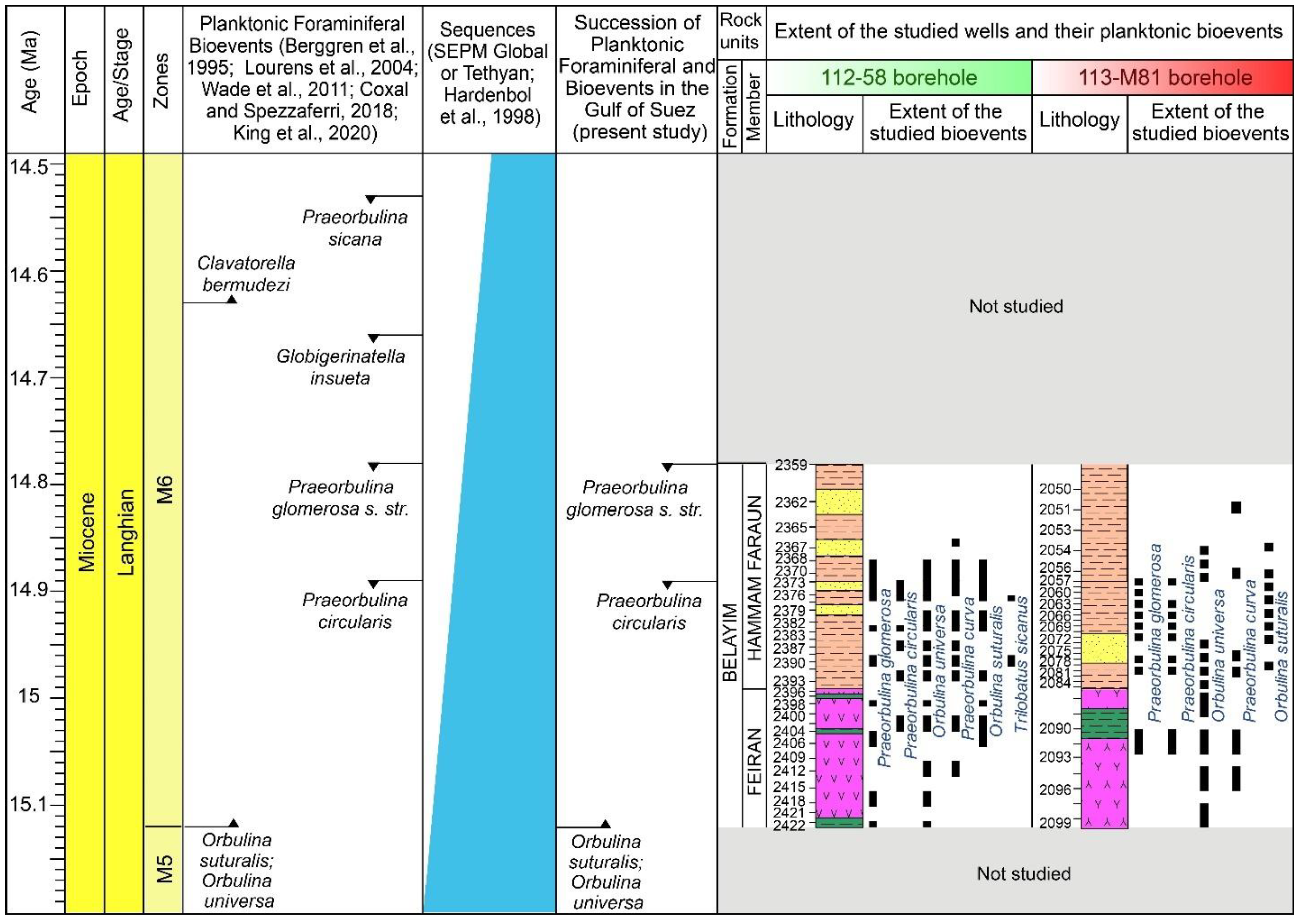

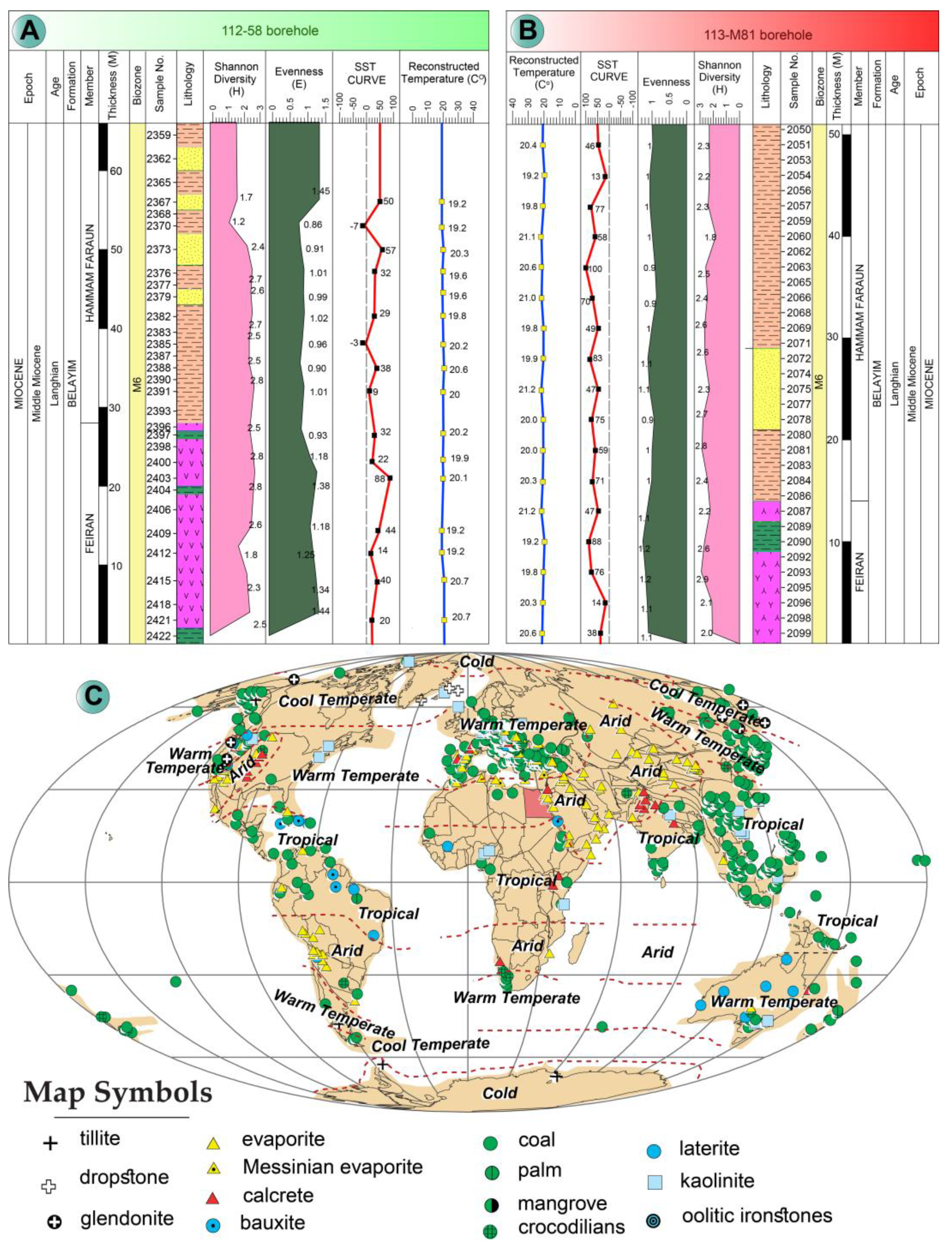
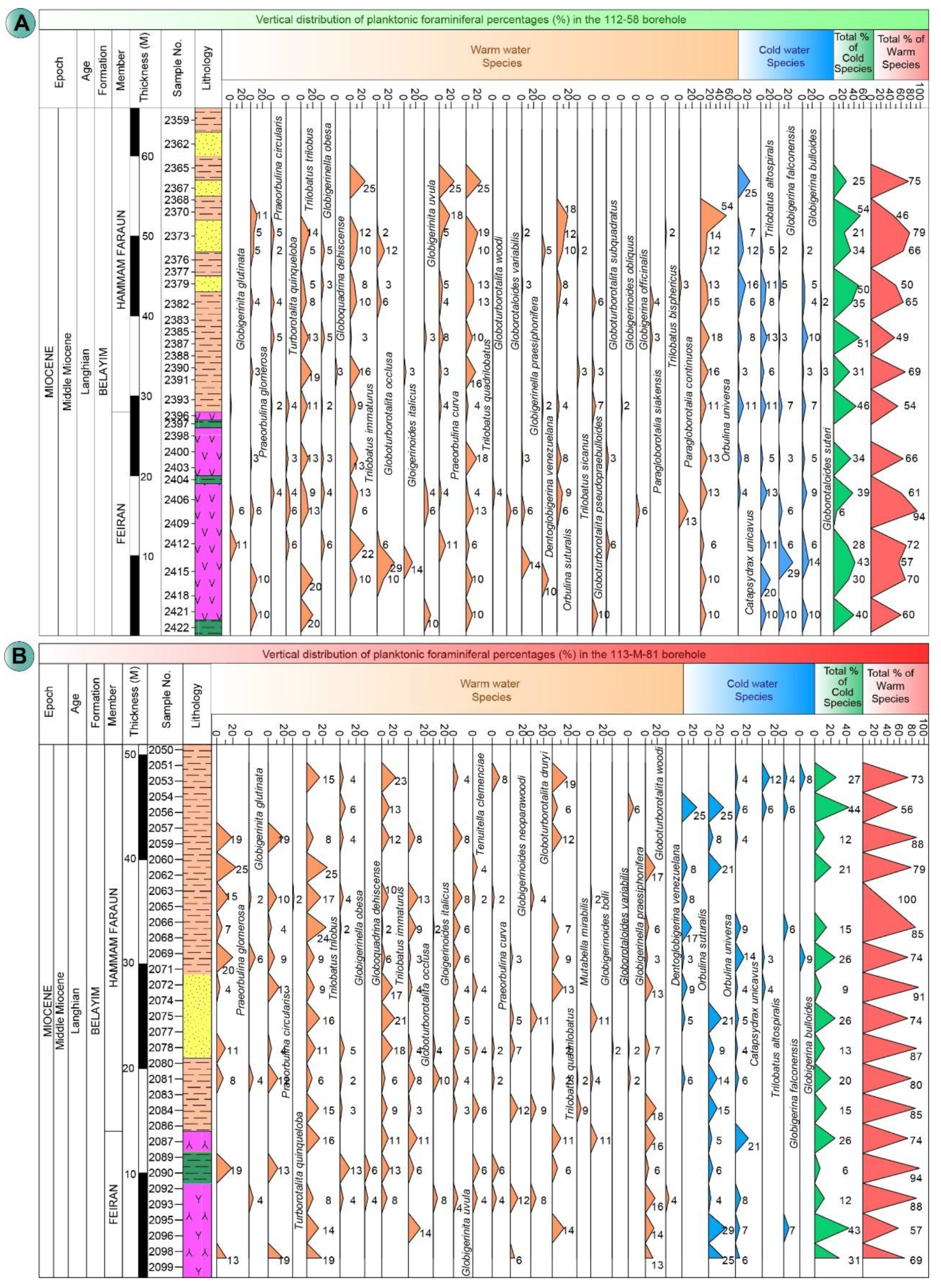
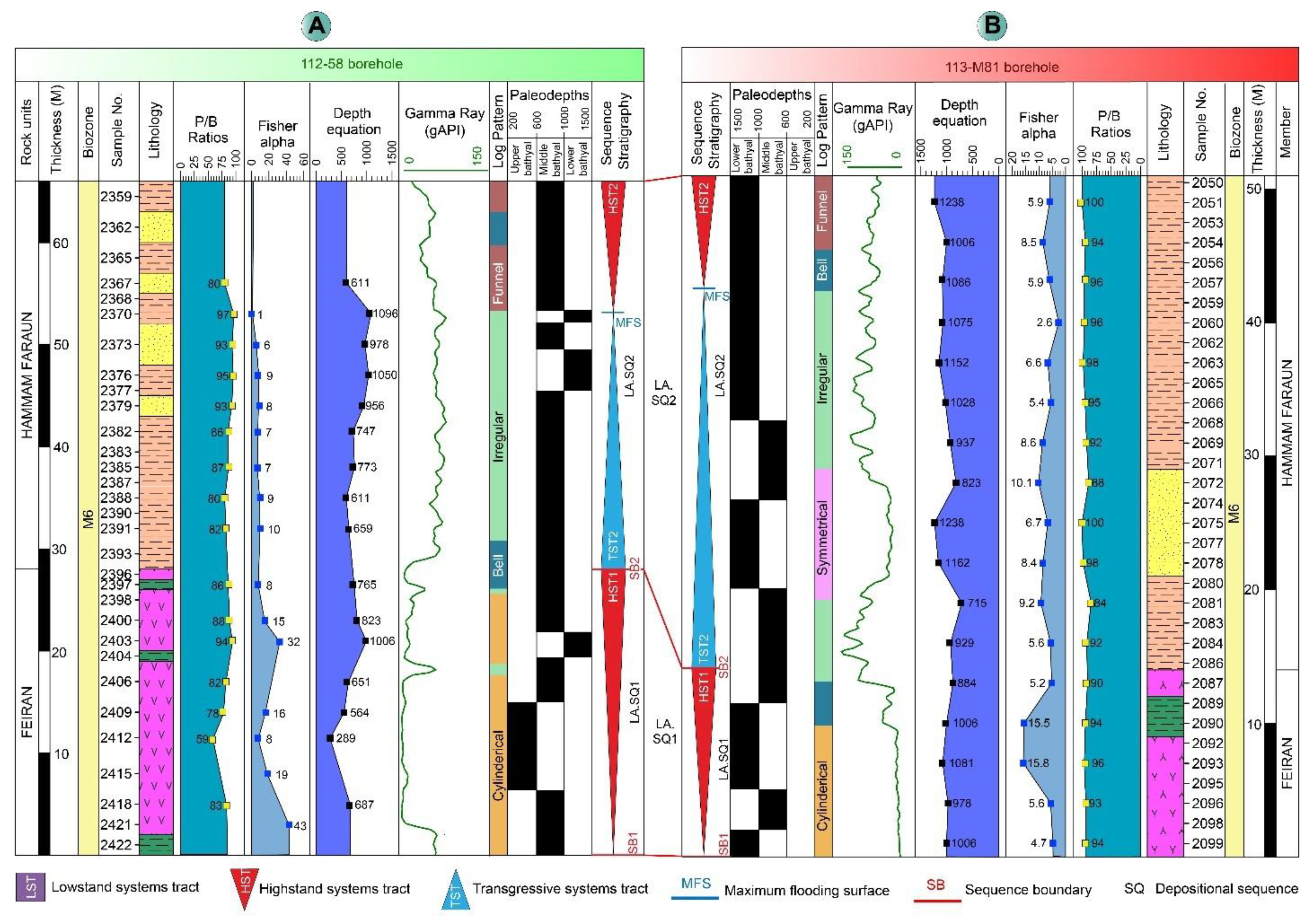
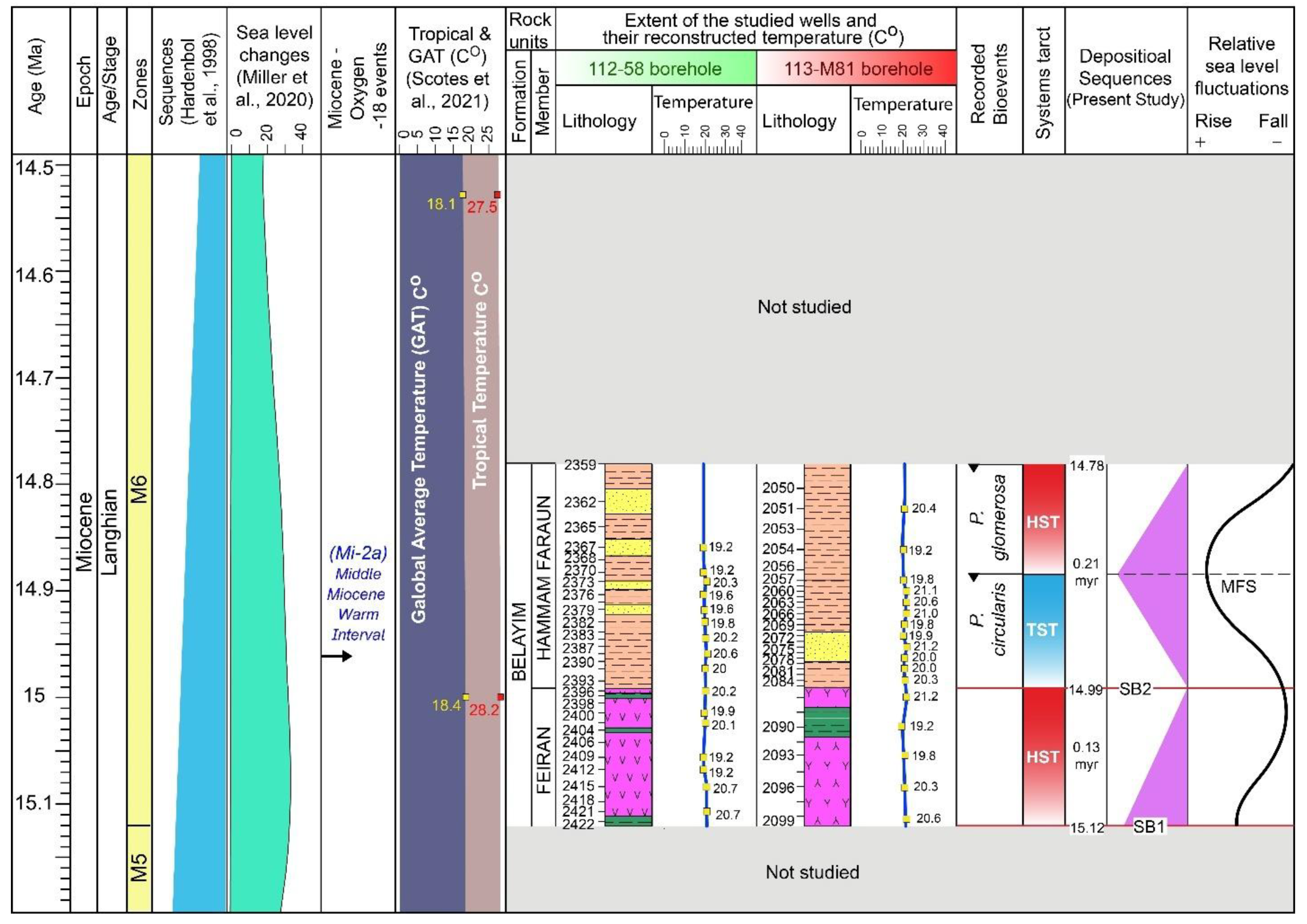
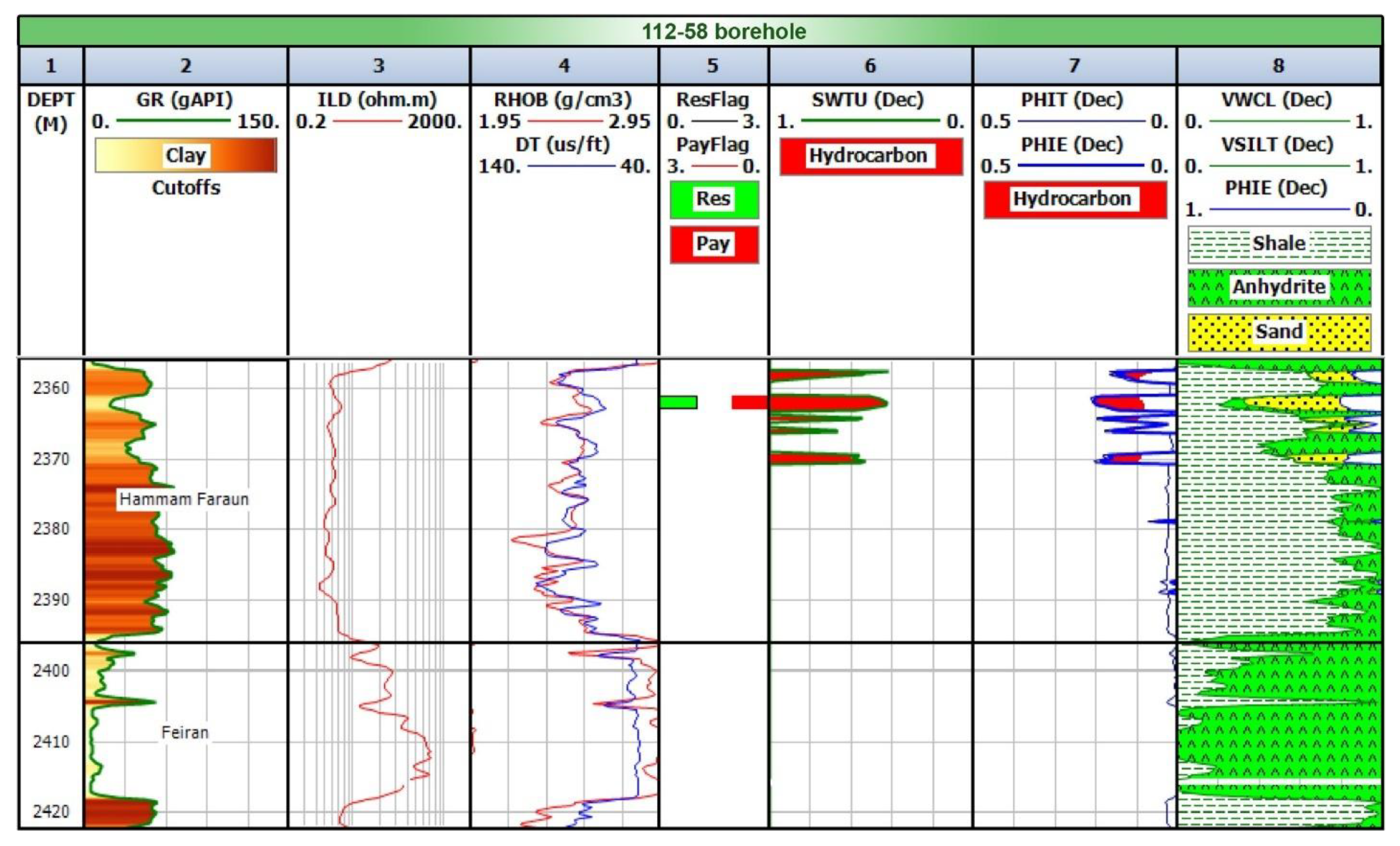

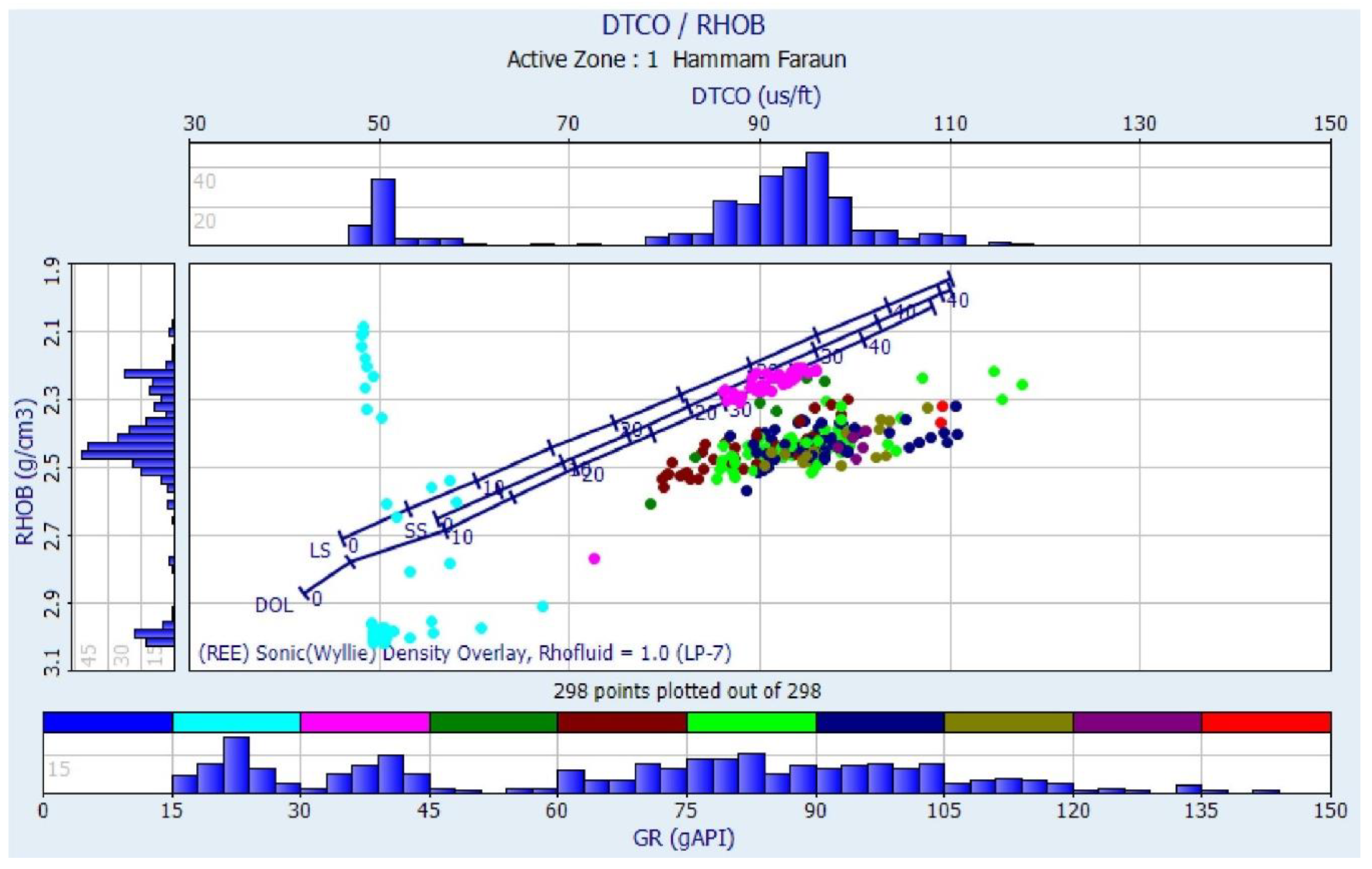
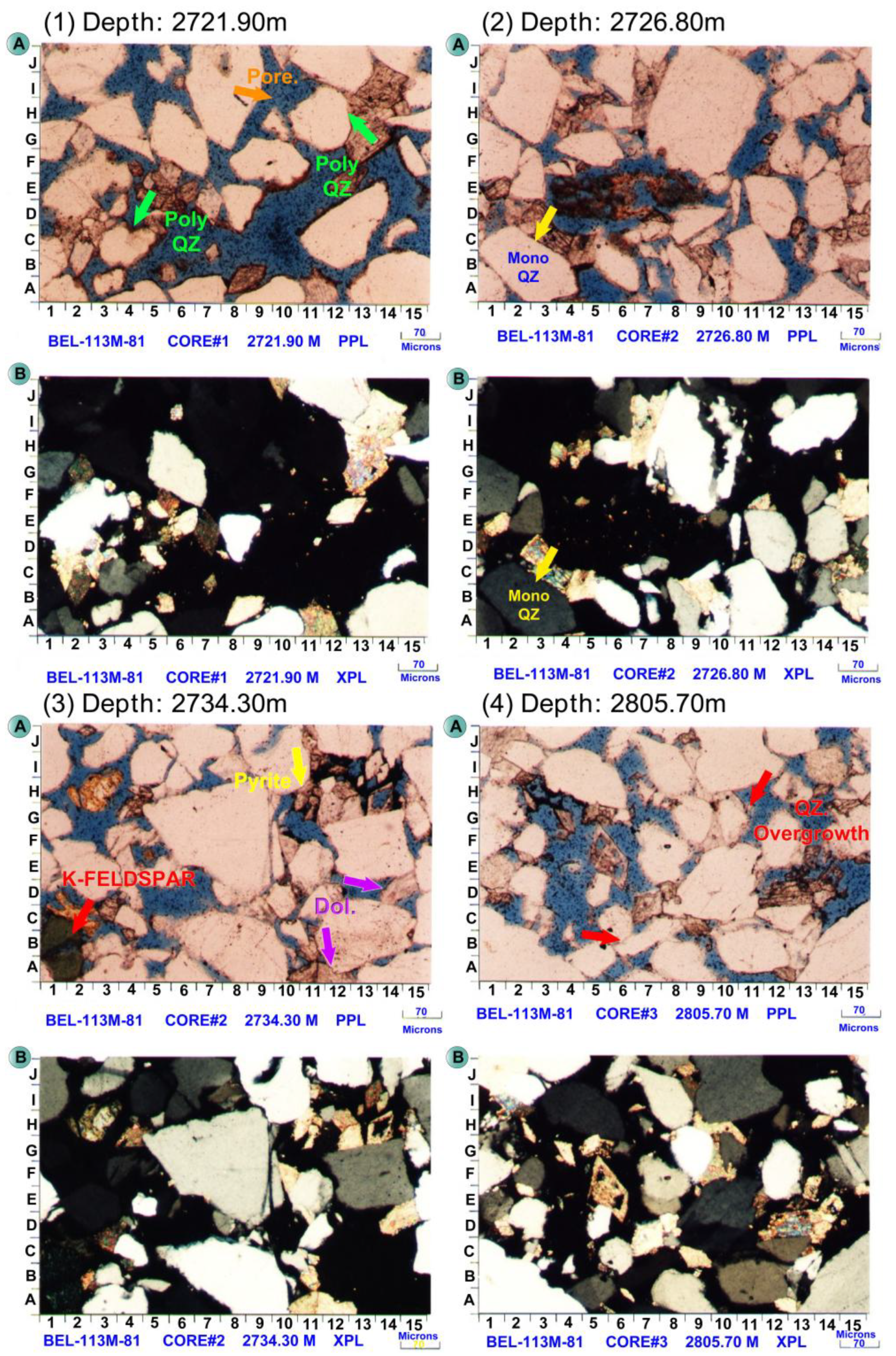
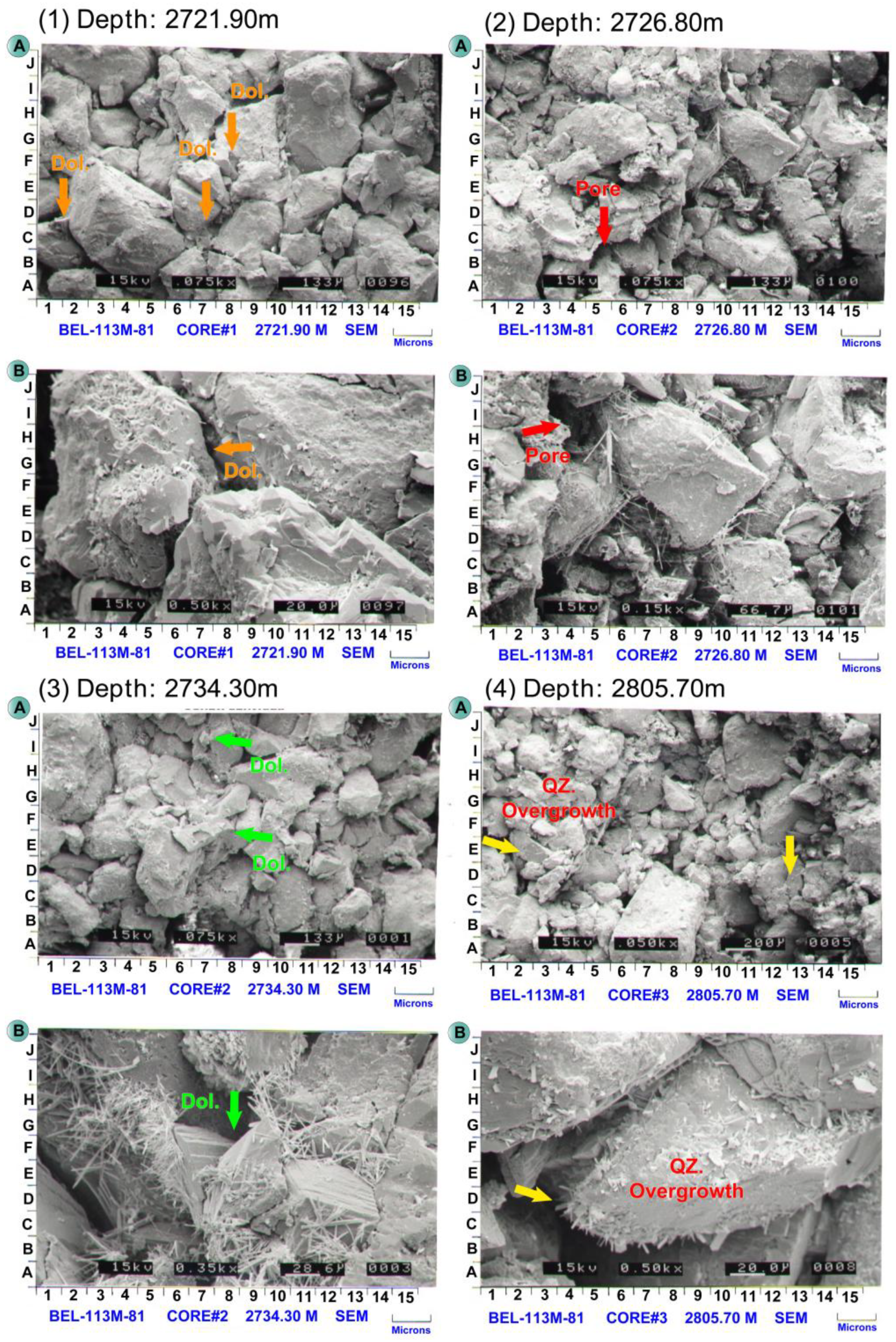
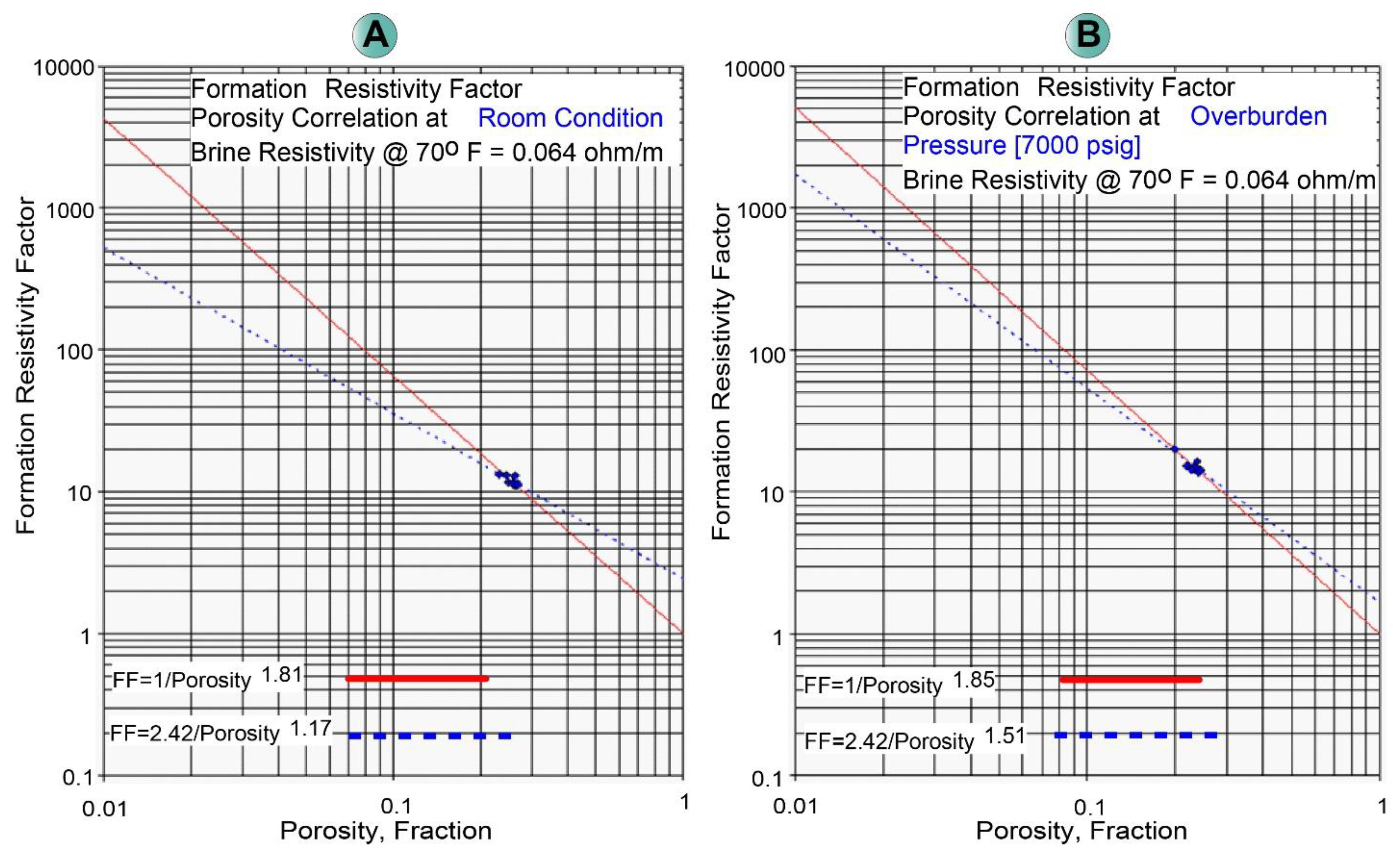


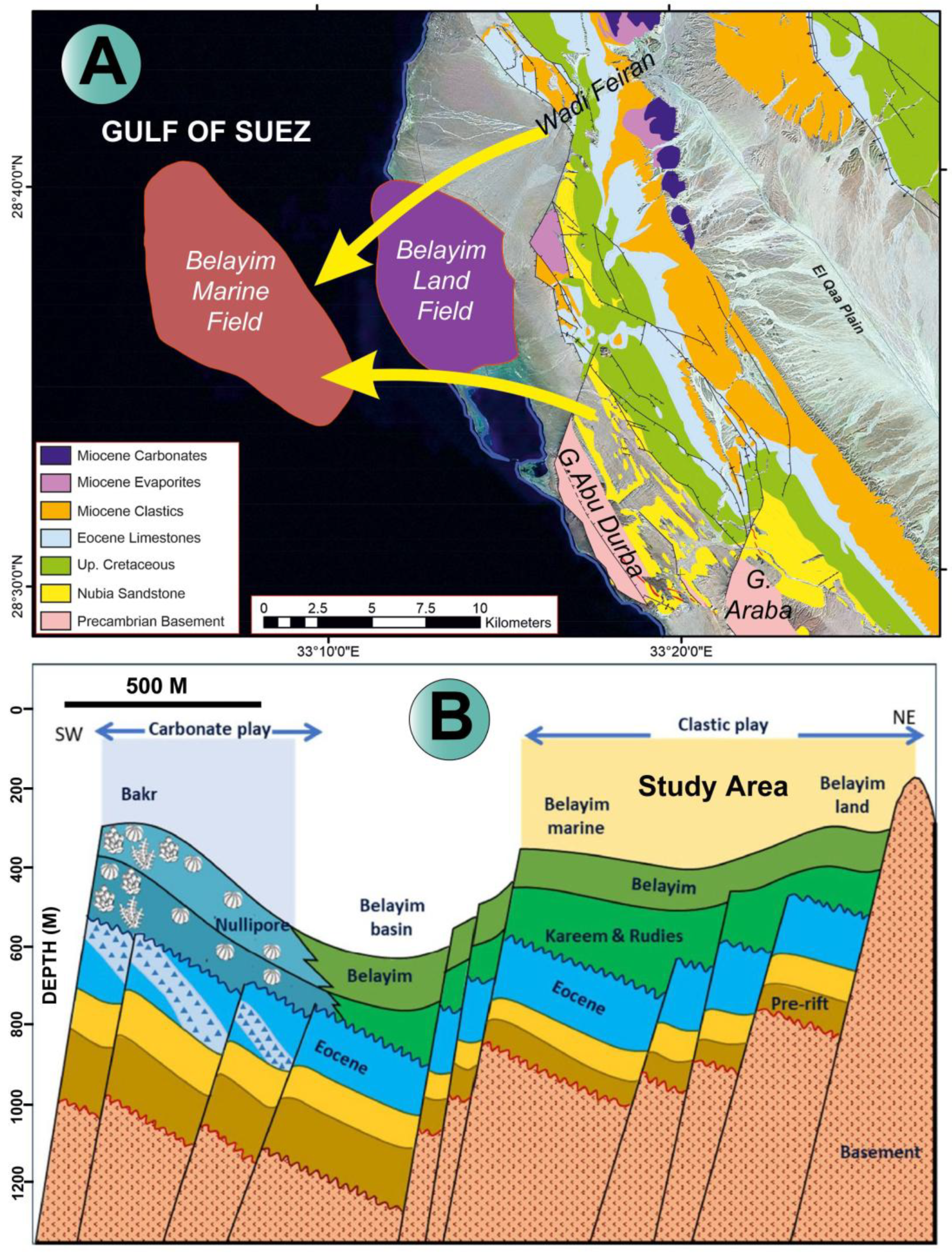
| Step | Protocol | Purpose |
|---|---|---|
| Disaggregation | 10% H2O2, 24-h reaction | Gentle clay removal |
| Sieving | 63 µm mesh | Isolate diagnostic > 63 µm fraction |
| Drying | 40 °C oven | Prevent test dissolution/fragmentation |
| Imaging | SEM (20 kV); Adobe Photoshop CS4 | Morphometric analysis & taxonomic validation |
| Taxonomy | Integrated Mikrotax databases + peer-reviewed schemes | Ensure consistency with global biostratigraphic standards |
| Bioevent | Age (Ma) | Depth (m) | Member Boundary |
|---|---|---|---|
| FAD O. suturalis | 15.12 | 2422 (112-58) | Base Feiran |
| LAD P. circularis | 14.89 | 2373 (112-58) | Feiran/H.F. transition |
| LAD P. glomerosa | 14.78 | 2359 (112-58) | Top Hammam Faraun |
| Well Name | Reservoir | Net Pay Thickness (m) | Effective Porosity (%) | Shale Content (%) | Water Saturation (%) | Hydrocarbon Saturation (%) |
|---|---|---|---|---|---|---|
| 112-58 | Hammam Faraun | 1.8 | 19 | 26 | 45 | 55 |
| 113M-81 | 2.7 | 17 | 41 | 67 | 33 |
| Control Factor | Eastern Gulf (Hammam Faraun Member) | Western Gulf (Nullipore Reservoir) |
|---|---|---|
| Paleobathymetry | Bathyal depths (>600 m); light-limited carbonate suppression | Neritic depths (<100 m); optimal for photic-dependent biota |
| Depositional Environment | Deep marine (bathyal; >600 m); high-energy, turbid conditions | Shallow marine (neritic; <100 m); clear, stable waters |
| Tectonics | Active syn-rift subsidence; fault-controlled sediment remobilization | Stable horst blocks; minimal structural disruption |
| Sediment Supply | High clastic influx (proximal to Nubian Shield sources) | Limited terrigenous input; dominance of in situ carbonate production |
| Sea-Level Dynamics | High-frequency, high-amplitude fluctuations disrupt carbonate factories | Stable sea levels enable continuous carbonate growth and reefal continuity |
Disclaimer/Publisher’s Note: The statements, opinions and data contained in all publications are solely those of the individual author(s) and contributor(s) and not of MDPI and/or the editor(s). MDPI and/or the editor(s) disclaim responsibility for any injury to people or property resulting from any ideas, methods, instructions or products referred to in the content. |
© 2025 by the authors. Licensee MDPI, Basel, Switzerland. This article is an open access article distributed under the terms and conditions of the Creative Commons Attribution (CC BY) license (https://creativecommons.org/licenses/by/4.0/).
Share and Cite
Ayyad, H.M.; Semary, H.E.; Fathy, M.; Hassan, A.H.I.; Ben Ghorbal, A.; Reda, M. Multifactorial Controls on Carbonate–Clastic Sedimentation in Rift Basins: Integrated Foraminiferal, Sequence Stratigraphic, and Petrophysical Analysis, Gulf of Suez, Egypt. Minerals 2025, 15, 864. https://doi.org/10.3390/min15080864
Ayyad HM, Semary HE, Fathy M, Hassan AHI, Ben Ghorbal A, Reda M. Multifactorial Controls on Carbonate–Clastic Sedimentation in Rift Basins: Integrated Foraminiferal, Sequence Stratigraphic, and Petrophysical Analysis, Gulf of Suez, Egypt. Minerals. 2025; 15(8):864. https://doi.org/10.3390/min15080864
Chicago/Turabian StyleAyyad, Haitham M., Hatem E. Semary, Mohamed Fathy, Ahmed Hassan Ismail Hassan, Anis Ben Ghorbal, and Mohamed Reda. 2025. "Multifactorial Controls on Carbonate–Clastic Sedimentation in Rift Basins: Integrated Foraminiferal, Sequence Stratigraphic, and Petrophysical Analysis, Gulf of Suez, Egypt" Minerals 15, no. 8: 864. https://doi.org/10.3390/min15080864
APA StyleAyyad, H. M., Semary, H. E., Fathy, M., Hassan, A. H. I., Ben Ghorbal, A., & Reda, M. (2025). Multifactorial Controls on Carbonate–Clastic Sedimentation in Rift Basins: Integrated Foraminiferal, Sequence Stratigraphic, and Petrophysical Analysis, Gulf of Suez, Egypt. Minerals, 15(8), 864. https://doi.org/10.3390/min15080864









